|
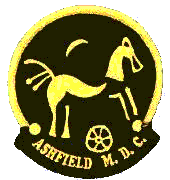
| |
JOHN RADFORD PROUDLY SHOWS OFF HIS NEW
DETECTOR.
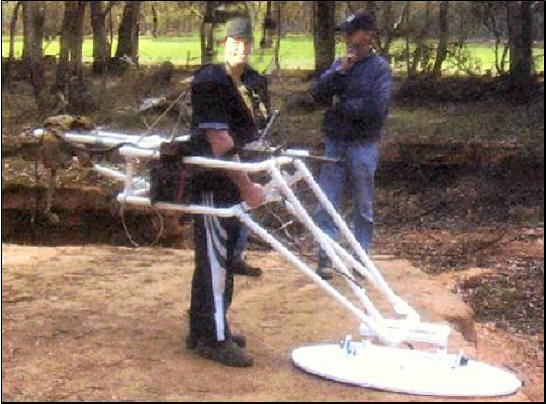
|
John
Radford has kindly allowed the use of this photograph of
himself demonstrating his new Minelab detector. John says
that it is fantastic with a depth of three yards on a cut
half. The only drawbacks are that it is a tad heavier than
his old Explorer and he only has time on a search to dig two
signals. Most of the time being taken up by excavation and
having to shore the sides of the hole up in compliance with
‘Health and Safety’ regulations! Unfortunately the machine
does not discriminate so John is well on the way to having
one of the best collections of rusted iron in the club.
Minelab have designed their new detector after the lunar
exploration probes naming it the ‘Lunatech. It is reasonably
priced it at £9,999.99.
|
|
FIND OF THE MONTH
NOVEMBER
Coin:- John silver hammered penny.
Found by Dennis Brown.
Artefact:-
Roman brooch 1st./2nd. century. Found by Jonathan Bryant, |
 |
 |
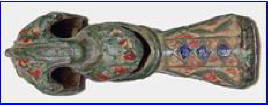 |
|
FIND OF THE MONTH DECEMBER |
Coin:- Edward111 hammered
silver penny. Found by John Wardle.
No image available.
Artefact:- Large mount. Found by John Wardle.
|
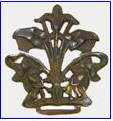 |
|
FIND OF THE MONTH JANUARY
Coin:. Roman bronze of Faustina Junior. Found
by Jeff Oscroft.
Artefact:- 17th. Century silver buckle. Found by
Jeff Oscroft. |
|
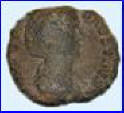 |
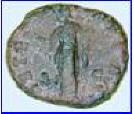 |
 |
|
FIND OF THE MONTH FEBRUARY |
Coin:- Silver hammered penny of
Matilda or Stephen. Found by Graham Reedman.
Artefact:- Silver salt spoon, the bowl is made
from an Indian two anna coin dated 1897. Found
by Dennis Brown. |
|
 |
 |
 |
|
OTHER FINDS MADE SINCE
LAST NEWSLETTER |
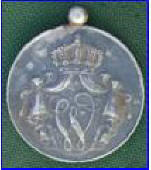
Dutch long service medal. Awarded for 24
years meritorious service. |
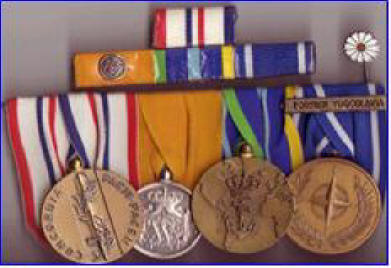
Set of medals Derek's is second left. |
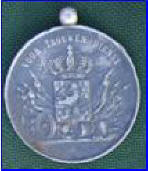
Found by Derek Crabtree on a club
search. |
MONEY TO MONEY
A
ten pound note found by the club
treasurer, Mary Severn, on a club
search. Judging by its condition it
had not been recently lost.
Exhaustive enquiries were made but
the loser could not be traced. (Much
to Mary’s delight). |
 |

|
Whistle and a cut half penny
found by David Hallam. |
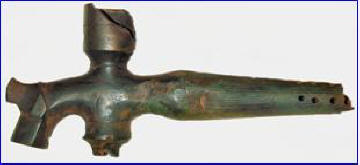
Barrel tap found by Jeff Oscroft |
|
|
 |
| |
|
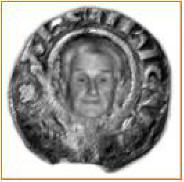 |
KING DENNIS the FIRST
This is a mystery coin. It
appears to be a short cross
silver penny and although
the face is clearer than
usual no one has put a name
to it. It has been suggested
that it bears a resemblance
to our chairman, Dennis
Brown but that has been
disregarded mainly because
even he was not around in
the 12th. century!
|
|
ANNUAL
GENERAL MEETING 2008 -
2009 HELD ON 2ND. MARCH,
2009
COMMITTEE FOR 2008 -
2009 |
 |
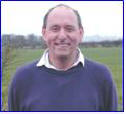 |
 |
 |
CHAIRMAN
Dennis Brown |
SECRETARY
John Radford |
TREASURER
Mary Severn |
SEARCH
SECRETARY*
Paul Wigginton |
|
COMMITTEE |
| |
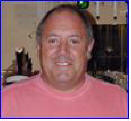
Dave Rhodes |
|
|

Jonathan Bryant |
|
| |
|

Pat Walker |
|
|
| |
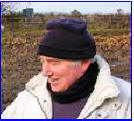
Bill Severn |
|
|
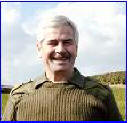
John Wardle |
|
ANNUAL GENERAL
MEETING
The
March, 2009, club
meeting was the
Annual General
Meeting. The members
pictured above were
elected to form the
new committee for
the year ahead. The
position of site
secretary was left
open for a review of
the post to be made.
*In the meantime
Paul Wigginton will
carry out the duties
until the matter is
clarified.
|
CHAIRMAN'S AWARD
PRESENTATION
|
|
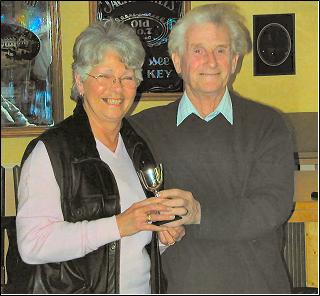
Mary Severn
Dennis Brown |
|
The Chairman’s
Award this year
was awarded to
the club
treasurer, Mary
Severn, for
being, in his
opinion, the
person who has
contributed most
to the club in
the past year. |
Treasure
Valuation
Committee
Finds of
Treasure
where an
abated
reward has
been made.
Report by
Trevor
Austin.
Advice
Some metals,
when removed
from the
ground, such
as gold or
silver-gold
alloy, can
be readily
identified
without
cleaning,
however it
is best not
to attempt
to clean any
find you
discover.
Keep the
find in a
dry stable
condition
and take it
to a museum
or your
local finds
Liaison
Officer (FLO)
for
professional
advice. The
original
surface can
yield
important
information
about the
object’s
manufacture
or use.
A series of
advice
leaflets
will be
produced
shortly by
the Portable
Antiquities
Scheme which
should prove
an
invaluable
source of
information
for the
storage and
conservation
of finds.
Finds of
Treasure
Where an
Abated
Reward has
been made
between 1999
and 2004.
Anglo Saxon
Pommel.
Discrepancy
over find
spot. 10%
from finders
share
Bronze Age
Jewellery
Conflicting
evidence as
to whether
landowners
had given
permission
to finders.
10% from
landowners
share added
to finders
share.
Gold Coins.
Failure to
report after
advice
within 14
days. Police
recovered
coins. 50%
from finders
share, i.e.
25% of
total.
Silver
Spoon.
Inexpert
cleaning 20%
from finders
share.
Gold Staters.
Failure to
report
within 14
days. (coins
found
gradually
over 2
years).
Coins had
not been
reported
promptly or
honestly.
Attempted
amateur
excavation
of find
site. 60% of
total.
Medieval
Finger Ring.
Failure to
seek
permission
to detect. 2
months delay
in
reporting.
5% from
finders
share.
Roman Coins.
Police had
to recover
quantity of
coins. Not
reported
promptly.
60% from
finders
share.
Romano
British
Finger Ring.
Heavy
cleaning
which may
have led to
loss of
decoration.
20% from
finders
share.
Anglo Saxon
Mount.
Soldering
together of
two
fragments
and failing
to record
find-spot.
Also failed
to ask
permission
of
landowner.
15% from
finders
share.
*** |
EMAIL
RECEIVED
BY JON
WELCH
OUR
WEBMASTER.
Hello
Webmaster,
The
button
found by
Eric
Pursglove
on your
summer
2008
newsletter
is a
woman’s
livery
button.
A
woman’s
coat of
arms is
in a
lozenge,
and this
is a
prettied
up shape
of a
lozenge.
The arms
in side
are
quartered,
so
probably
she
could
bear
arms
inherited
from her
father,
husband
etc. If
there is
a back
mark on
the
button
this
site may
help
with
dating
the
button:
http://www.ukdfd.co.uk/pages/buttonsgtom.html
regards,
Jenny
Swindells.
A button
collector
who
lives in
Nottingham.
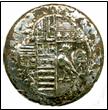
The club
would
like to
thank
Ms.
Swindells
for her
identification
of
Eric’s
button.
If any
member
collects
or is
interested
in
buttons
of all
types
please
contact
The
British
Button
Society
on their
website
www.britishbuttonsociety.org.
for
membership
details.
|
Priscilla
Langridge
has
kindly
given
permission
for
her
article
about
Masonic
Tokens
in
the
Coin
Monthly
December
1971
to
be
reproduced
here.
PART
ONE
MASONIC
TOKENS
Priscilla Langridge
It
is
not
often
that
one
has
the
opportunity
to
buy
the
Masonic
token,
known
as
The
‘Mark
Penny'.
Occasionally
one
either
turns
up
in a
collection
of
coins,
or
may
even
be
found
in
one's
change
as
was
the
‘Stock
Mark
Penny',
with
1928
penny
reverse,
and
the
incuse
keystone
on
smoothed
obverse
(found
by
E.J.
King
of
Banbury).
These
tokens,
generally
overlooked
by
numismatists,
can
mystify
the
finder
unless
he
is a
member
of
the
fraternity.
When
studied
these
'Mark
Penny'
tokens
can
be
quite
intriguing.
An
interesting
collection
can
be
made,
and
if
time
is
spent
in
delving
into
Masonic
allegory
and
the
mystical
signs
used,
quite
a
fascinating
field
is
opened
up
for
study.
The Masonic collector may have difficulty in obtaining
specimens
as
members
of
the
Chapters
cherish
their
'Mark
Pennies'
highly,
and
seldom
part
with
their
own
specimen.
Some
Chapters
are
prepared
to
sell
or
exchange
their
penny
tokens,
but
it
appears
that
the
practice
of
giving
these
is
dying
out,
and
hence
few
are
obtainable
in
Great
Britain.
These
tokens
originated
from
an
old
custom
of
giving
tokens,
whether
in
lead,
wood,
or
metal
of
some
kind,
to
travelling
Masons.
With
these
tokens
a
Mason
was
ensured
recognition
and
hospitality.
Among
the
ancients
of
mythology,
Jason
(of
the
Golden
Fleece)
promises
Medea,
on
her
parting
from
him
to
send
her
the
symbols
of
hospitality,
which
would
have
ensured
for
her
a
kind
reception
in
foreign
countries.
The Romans used small tessarae of bone, ivory. stone
and
lead
suitably
inscribed
and
broken
into
two
halves
which
could
be
matched
at a
future
time
and
friendship
renewed.
Mackay
says
that
tessarae
were
a
means
of
introduction
of
Christian
to
fellow
Christian.
Tokens recorded as 'Jetons de Presence' were given in
French
lodges
to
Masons
present
such
as
are
given
today
to
Brethren
entering
a
Grand
Lodge.
At one time it was common practice for each lodge to
have
its
own
special
dies
made,
each
with
carefully
engraved
symbols
pertaining
to
the
Chapter.
At
the
founding
of a
lodge,
founder
members
would
receive
their
penny
as a
symbol
of
brotherly
fellowship.
Special tokens are manufactured from engraved dies for
those
Masons
who
attain
a
high
degree
and
on
these
we
see
inscribed
the
keystone
and
THEY
RECEIVED
EVERY
MAN
A
PENNY.
Some Masonic tokens arc made to commemorate special
Chapter
anniversaries
such
as
the
founding
of a
lodge.
All
these
little
metallic
tokens
symbolise
friendship
and
brotherly
love
and
bear
a
mute
testimony
throughout
the
ages.
To
Mark
Masters
they
are
the
emblem
'of
a
day's
wages'.
Tradition
relates
that
St.
Alban,
born
300
AD
at
Verulanium
(now
St.
Albans)
'...
loved
Masons
well
and
cherished
them
much,
for
he
gave
them
two
shillings
per
week
and
fourpence
to
cheer
them.
whereas
before
that
time,
in
all
the
land
a
Mason
had
but
a
Penny
a
Day
and
his
meat
until
St.
Alban
mended
it.
Some Chapters do not necessarily wish to have their own
engraved
dies
made
and
use
the
manufacturer's
'Stock
Mark
Pennies'.
These
are
not
so
interesting
and
usually
fairly
plain
sometimes
with
a
countersunk
design
and
arc
generally
devoid
of
beauty.
Other
Masonic
tokens
are
more
like
medalets
since
they
are
of
keystone
shape
instead
of
the
general
round
type.
These
are
generally
made
in
copper
or
bronze
but
some
can
be
found
in
white
metal,
brass
and
silver.
A
few
are
engraved
with
a
particular
'Mark'
which
is
placed
on
record.
These
marks
arc
held
as
sacred
tokens
of
the
rites
of
friendship
and
brotherly
love.
(To
be
continued).

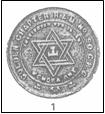
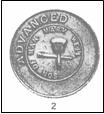
***
WATCH KEY WINDER FINDS NEW HOME.
The following is a series of emails to the club by Jeff Taylor of Ipswich.
*
I notice in your Summer 08 newsletter that you have a picture of a watch key winder for J Fowler, Derby Road, Nottingham. I am almost certain that this is my great grandfather John Fowler who ran a watchmaker/jewellers shop from various premises in Derby Road in the period 1880s to 1910.Would you be prepared to sell it? I would love to acquire it for a reasonable sum. Jeff Taylor.
Jon Welch the club website manager passed your email on to me because I compile the club newsletter also the J. Fowler watch key is included in my collection of named watch keys. I have collected these keys over the past thirty years and the one in question was found by me at Bulwell Hall Park, Nottingham about twenty five years ago. It is in reasonable condition apart from the ring being missing, unfortunately this is not uncommon. If you email your address I will send the watch key to you. There is no question of payment, it is part of your family history and should be with you. However if you can provide me with any details of John Fowler likely to interest readers of the newsletter I would appreciate it and possibly include them in the March/April issue. John Gough.
The Watch Key Winder arrived safely this morning. What a find it is and in such good condition. All the family send their thanks. My elder sister did have a Fowler watch but this was sadly lost in a burglary some years ago. The watch key winder is the only artefact that we have from the Fowler watchmaker days so it will be very treasured. The address on it is 54 Derby Road and I confirm he was at this address as early as September 1887 when his wife gave birth to twins. Sadly we don't have a picture of John Fowler, but I do have one of my grandfather Walter which is enclosed.
John Fowler born 6 November 1850 in Chesham, Buckinghamshire married Emma Jane HUNT in London 20 May 1872. Emma died of TB 23 May 1895 in Nottingham John remarried Harriet MARSHALL in Nottingham 1 Feb 1901. John died 13 July 1914. John and Emma had 7 children including John Walter (known as Walter) born 23 October 1880 in Chesham. John is listed as a watchmaker and jeweller on Chesham High Street in 1871 and 1881 censuses
Both my great grandfather John Fowler (born 1850) and my grandfather Walter Fowler (born 1880) were watch makers & jewellers. They were both born in Chesham, Buckinghamshire and John learnt his trade with the Jordan family at Chesham who made fine clocks, which sometimes come up for sale. The family came to Nottingham in the 1880s and occupied several shops over the years for their trade in Derby Road. Around 1900, Walter moved to St Ann’s Well Road where he operated his own watchmaker business. Towards the end of his working life John operated from 541 Mansfield Road. He died in 1914.
Once again many thanks for your kindness in sending this to us. Jeff Taylor. |
|

Walter Fowler
|
 
Watch key winder
Much enlarged.
|
***
|
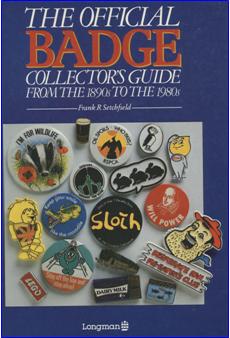
|
BOOKS
The book for this newsletter is The Official Badge Collectors Guide from the 1890s to the 1980s., by Frank R Setchfield. This is a guide to button and lapel badges and does not cover military badges. I can not remember when I bought this book, possibly the early 1990s., or how much I paid for it. However it was certainly cheaper that the £74.95 asked for by Amazon Books!
It is a lavishly colour illustrated book of 188 pages showing over 2,000 badges from the Boer War to Band Aid with descriptions of their purpose and origins.
Whilst the book cannot include all the types of badges that have been issued it has a good selection of metal enamelled badges that are most likely to be found by metal detectorists.
Displayed (below) the badge 5th. right 2nd. row is for the 1943 film Stormy Weather staring Bill Robinson and Lena Horne. JMBG |
|
A SMALL DISPLAY OF BADGES FOUND WITH A METAL DETECTOR
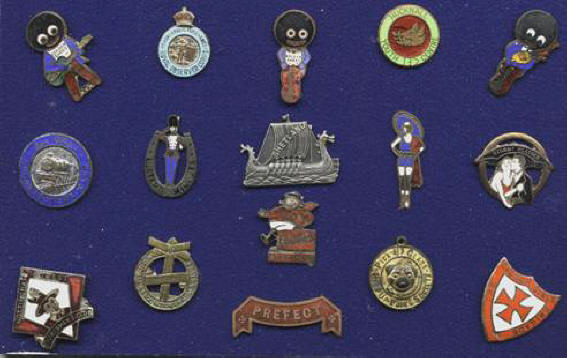
***
|
|
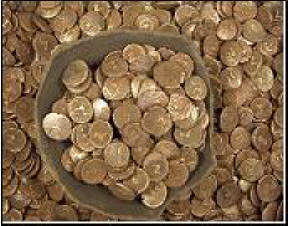 |
THE STUFF DREAMS ARE MADE OF!
A metal detectorist has found a hoard of 824 gold staters thought to be the biggest hoard of gold Iron Age coins since 1849 when a farm worker unearthed about 2,000 gold staters near to Milton Keynes.
This latest hoard was found in a broken pot in land near to Wickham Market, Suffolk. The coins date from 40BC. to AD. 15 and were minted by the Iceni. They are at present going through the Treasure Act procedure.
|
FIGURES ON ROMAN COIN REVERSES
Here is the third set of ten drawings of figures that may be found on the reverses of Roman coins found in Britain.
|
|

|
|
21. Liberalitas 22. Libertas 23. The Three Monetae 24. Nobilitas 25. Pax |
 |
|
26. Pietas 27. Providentia 28. Pudicitia 29. Salus 30. Securitas |
|
21. LIBERALITAS. Liberality. Holding a tablet (tessera) and cornucopia, horn of plenty.
22. LIBERTAS. Freedom. Liberty. Holds the pileus (pointed cap of Liberty) and sceptre.
23. THE THREE MONETAE. Mint or Money, holds scales and cornucopia. Each with a
pile of coins at their feet.
24. NOBILITAS. Nobility. Holds palladium (image of Pallas or Minerva) and sceptre.
25. PAX. Peace. Holds olive branch and sceptre.
26. PIETAS. Piety, Dutifulness. Often veiled holds box of perfumes, sacrificing at an altar.
27. PROVIDENTIA. Providence, Forethought. Holds baton pointing to a globe at her feet,
and a sceptre.
28. PUDICITIA. Modesty, Charity. Holds sceptre often veiled.
29. SALUS. Health, Safety and Welfare. Holds sceptre and patera (a round shallow dish or
vase) feeding a serpent coiled round an altar, or holds the serpent in her arms.
30. SECURITAS. Confidence, Security. Holds patera or sceptre and may be leaning on a
column, legs crossed. Sometimes sitting in a chair.
*** |
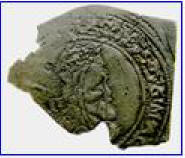 |
TRIAL PIECE
The illustrated trial piece of a one shilling was found with a metal detector about thirty years ago at Papplewick. It is believed that it was used to test the accuracy of the coin dies used to produce counterfeit coinage of James 1 1603—1625.
|
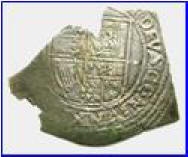 |
|
GREAT SEAL OF THE KING OF ENGLAND
JOHN 1199—1216. |
 |
|
A TOPICAL SKETCH BY JOHN RADFORD.
|
|

|
|
|
|
